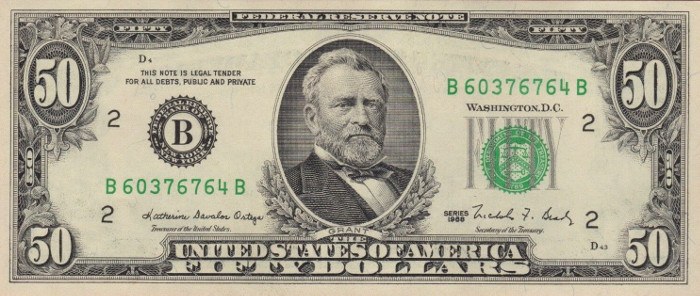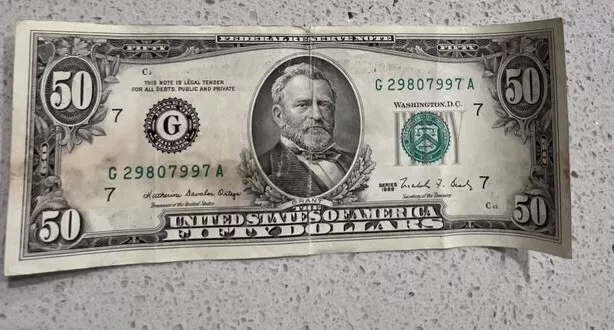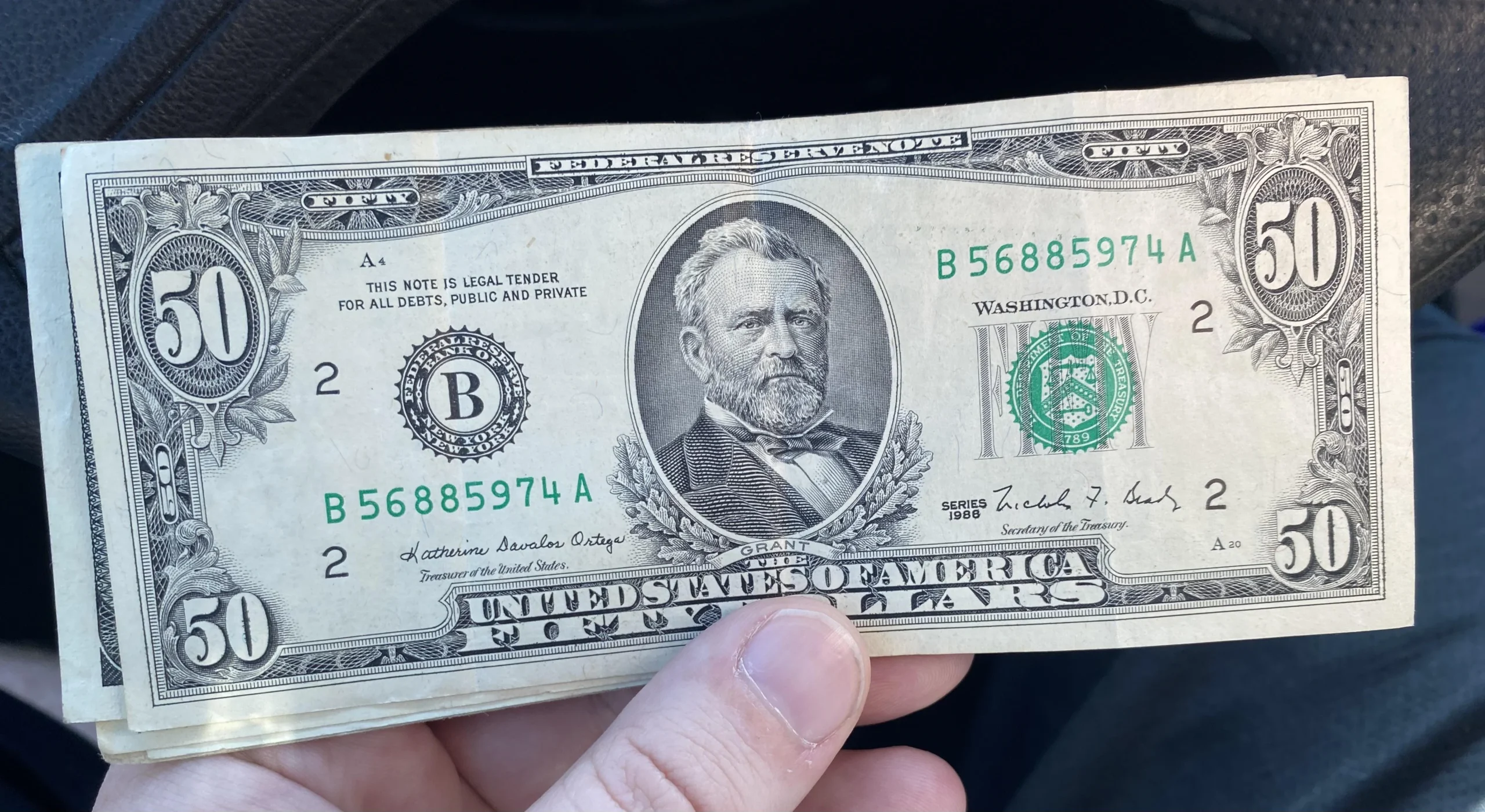The 1988 50 dollar bill, part of the U.S. currency system, holds an interesting place in the world of paper money. While the majority of these bills aren’t particularly valuable beyond their face value, certain factors such as condition, star notes, and errors can make them more collectible and sought after.
In this article, we will delve into the specifications, value, star notes, and unique characteristics of the 1988 50 dollar bill, as well as how to tell if a bill is real.

A collector or simply curious about the worth of old paper money, understanding the finer details of the fifty dollar bill from this series is key to evaluating its true value.
Specifications Of The 1988 50 Dollar Bill
Before diving into the worth and rarity of the 1988 50 dollar bill, it’s important to understand its physical characteristics.
This bill is part of the Federal Reserve’s 1988 series, which features some important updates to security features and design compared to earlier series.
- Denomination: $50.00 USD
- Type: Federal Reserve Note
- Signature Combinations: The 1988 50 dollar bill features the signatures of two U.S. Treasury officials, Treasury Secretary James A. Baker III and Treasurer of the United States Catherine A. Reuben.
- Series: One: 1988
- Design: The front of the bill features a portrait of Ulysses S. Grant, the 18th president of the United States, while the back features the U.S. Capitol building.
This fifty dollar bill was part of a broader redesign effort to improve the security of U.S. currency, making it harder to counterfeit.
However, the most important aspect for collectors is its age, condition, and the presence of rarer variants, such as star notes or bills with printing errors.
1988 50 Dollar Bill Value
When it comes to the 1988 50 dollar bill, most of these bills in circulation won’t fetch more than their face value of $50. This is because, like most currency that’s been used, they typically show wear and tear that lowers their collectibility.

However, several factors can increase their worth, especially if the bill is in excellent condition or possesses rare attributes.
- Condition of the Bill: The condition of the bill plays a crucial role in its value. Uncirculated bills, which show no signs of wear or handling, can sell for more than face value. These bills are usually graded using a scale that ranges from Good to Uncirculated. For example, an uncirculated 1988 $50 bill in MS 63 condition (a mid-grade uncirculated bill) can be worth between $100 and $125.
- Star Notes: Star notes are replacement bills issued by the U.S. Federal Reserve when a bill is damaged during the printing process. These star notes are designated by a small star symbol at the end of the serial number. Because star notes are rarer than regular bills, they tend to command higher prices. For a 1988 $50 bill, a star note in uncirculated condition (rated MS 63) can be worth around $200 or more, depending on its rarity and condition.
- Error Bills: Occasionally, errors in the printing process can result in unique bills that are highly sought after by collectors. These errors might include misprints, misplaced seals, or misaligned designs. If you happen to find a 50 dollar bill from the 1988 series with a printing error, its value could be significantly higher than a standard bill in good condition.
The Impact Of Series and Issuer On Value
The 1988 50 dollar bill was issued as part of the larger series of currency released in that year. The series is known for certain upgrades, including enhanced security features, but bills issued from different Federal Reserve banks may differ in value as well.
For instance, 1988 $50 bills issued by the Federal Reserve Bank of Kansas City tend to sell for more in uncirculated condition.
Bills from this bank, when graded MS 63, can command a price as high as $175. This difference in value is due to the varying rarity of bills issued from different regions.
How Inflation Affects The 1988 50 Dollar Bill
When considering the worth of a 50 dollar bill from 1988, it’s also important to look at the economic context. The purchasing power of $50 in 1988 is not the same as it is today due to inflation.
In fact, $50 in 1988 is equivalent to about $133.39 today, based on the average inflation rate of 2.69% per year.
This increase of $83.39 over 37 years reflects the changing economic landscape, making the bill’s value more significant when adjusted for inflation.
How To Tell If A 1988 50 Dollar Bill is Real?
As with all currency, one of the most important questions for collectors and holders of the 1988 $50 bill is how to determine whether it is real or counterfeit.
There are several key features to look for when verifying the authenticity of a bill:
- Watermark: Hold the bill up to the light to check for a watermark. A genuine bill will show a watermark of Ulysses S. Grant, while counterfeit bills may lack this feature or display a faded watermark that doesn’t match the image on the front of the bill.
- Security Thread: A thin security thread embedded in the bill will glow under UV light, which is another important sign of authenticity.
- Microprinting: There is microprinting around various parts of the bill, which can only be seen clearly under magnification. This small print is difficult to reproduce and is another security feature to look for.
- Color-shifting Ink: The number “50” on the front of the bill is printed in color-shifting ink that changes from copper to green when the bill is tilted.
By using these methods, you can ensure that the fifty dollar bill is legitimate and not counterfeit.
Conclusion
The 1988 50 dollar bill is mostly worth its face value unless it is in pristine, uncirculated condition or features a unique characteristic, such as a star note or printing error.
For collectors, these rare bills are worth far more than their face value, with star notes and bills from specific Federal Reserve banks commanding premium prices.
The 1988 series itself holds a place in U.S. currency history, but it’s the specific details that make certain 50 dollar bills from that year highly collectible.
For those interested in buying, selling, or simply evaluating their 50 dollar bills, knowing how to identify the key features—like star notes, errors, and security measures—can make a significant difference in determining their true worth. Understanding the nuances of the 1988 50 dollar bill can offer valuable insights into the world of currency collecting.

